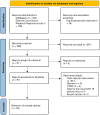Incidence of Diabetic Ketoacidosis Among Pediatrics With Type 1 Diabetes Prior to and During COVID-19 Pandemic: A Meta-Analysis of Observational Studies
- PMID: 35355556
- PMCID: PMC8959619
- DOI: 10.3389/fendo.2022.856958
Incidence of Diabetic Ketoacidosis Among Pediatrics With Type 1 Diabetes Prior to and During COVID-19 Pandemic: A Meta-Analysis of Observational Studies
Abstract
Background: Previous reports suggest that the Coronavirus Disease-2019 (COVID-19) pandemic might have affected incidences of diabetic ketoacidosis (DKA) and new diagnoses of type 1 diabetes. This systematic review and meta-analysis aimed to estimate the risk of DKA, including severe DKA, during the COVID-19 pandemic versus the prior-to-COVID-19 period among pediatric patients with type 1 diabetes.
Methods: PubMed and EMBASE were searched for observational studies investigating the risk of DKA among pediatric patients with type 1 diabetes during the COVID-19 pandemic and the prior-to-COVID-19 period. A random meta-analysis model was performed to estimate the relative risk of DKA during the COVID-19 pandemic compared to before the pandemic. Subgroup analyses were conducted based on the type 1 diabetes status, established or newly diagnosed. In addition, sensitivity analysis was conducted for studies that reported results from adjusted analysis for potential confounders using fixed effect model.
Results: A total of 20 observational studies reported the risk of DKA, of which 18 reported the risk of severe DKA. The risks of DKA and severe DKA were 35% (RR 1.35, 95%CI 1.2-1.53, I2 = 71%) and 76% (RR 1.76, 95%CI 1.33-2.33, I2 = 44%) higher in the during-COVID-19 group compared to the prior-to-COVID-19 group, respectively. Among patients with newly diagnosed type 1 diabetes, the risk of DKA was 44% higher for the during-COVID-19 group compared to the prior-to-COVID-19 group (RR 1.44, 95%CI 1.26-1.65; I2 = 64%). Only two studies reported the risk of DKA among patients with established type 1 diabetes and the cumulative risk was not statistically significant. In the sensitivity analysis, four studies reported an adjusted odds ratio (aOR) of the risk of DKA during COVID-19 compared to the prior-to-COVID-19 period. The fixed estimate from the meta-analysis found an increase in the risk of DKA in the during-COVID-19 group compared to the prior-to-COVID-19 group (aOR 2.04, 95%CI 1.66-2.50).
Conclusions: This study showed that DKA risk, especially the risk of severe DKA, has increased significantly during the pandemic. Healthcare systems must be aware and prepared for such an increase in DKA cases and take all necessary measures to prevent future spikes during the pandemic.
Systematic review registration: https://www.crd.york.ac.uk/prospero/display_record.php?RecordID=272775, identifier PROSPERO [CRD42021272775].
Keywords: COVID-19; diabetic ketoacidosis; incidence; meta-analysis; pediatrics; systematic review; type 1 diabetes.
Copyright © 2022 Alfayez, Aldmasi, Alruwais, Bin Awad, Al Yami, Almohammed and Almutairi.
Conflict of interest statement
The authors declare that the research was conducted in the absence of any commercial or financial relationships that could be construed as a potential conflict of interest.
Figures





Similar articles
-
Incidence of diabetic ketoacidosis during COVID-19 pandemic: a meta-analysis of 124,597 children with diabetes.Pediatr Res. 2023 Apr;93(5):1149-1160. doi: 10.1038/s41390-022-02241-2. Epub 2022 Aug 11. Pediatr Res. 2023. PMID: 35953513 Free PMC article.
-
Alarming increase in ketoacidosis in children and adolescents with newly diagnosed type 1 diabetes during the first wave of the COVID-19 pandemic in Israel.Pediatr Diabetes. 2022 Feb;23(1):10-18. doi: 10.1111/pedi.13296. Epub 2021 Dec 14. Pediatr Diabetes. 2022. PMID: 34865288
-
Impact of the COVID-19 pandemic on the incidence and clinical outcomes of diabetic ketoacidosis among male and female children with type 1 diabetes: systematic review and meta-analysis.F1000Res. 2023 Aug 10;12:72. doi: 10.12688/f1000research.128687.2. eCollection 2023. F1000Res. 2023. PMID: 39262444 Free PMC article.
-
The global impact of COVID-19 pandemic on the incidence of pediatric new-onset type 1 diabetes and ketoacidosis: A systematic review and meta-analysis.J Med Virol. 2022 Nov;94(11):5112-5127. doi: 10.1002/jmv.27996. Epub 2022 Jul 22. J Med Virol. 2022. PMID: 35831242 Free PMC article.
-
The Silent Epidemic of Diabetic Ketoacidosis at Diagnosis of Type 1 Diabetes in Children and Adolescents in Italy During the COVID-19 Pandemic in 2020.Front Endocrinol (Lausanne). 2022 Jun 17;13:878634. doi: 10.3389/fendo.2022.878634. eCollection 2022. Front Endocrinol (Lausanne). 2022. PMID: 35784550 Free PMC article.
Cited by
-
Plasma amino acid signatures define types of pediatric diabetes.Clin Nutr ESPEN. 2023 Oct;57:21-28. doi: 10.1016/j.clnesp.2023.06.005. Epub 2023 Jun 13. Clin Nutr ESPEN. 2023. PMID: 37739658 Free PMC article.
-
Covid 19 and diabetes in children: advances and strategies.Diabetol Metab Syndr. 2024 Jan 29;16(1):28. doi: 10.1186/s13098-024-01267-2. Diabetol Metab Syndr. 2024. PMID: 38287388 Free PMC article. Review.
-
Screening children for presymptomatic type 1 diabetes.Br J Gen Pract. 2022 Dec 21;73(726):36-39. doi: 10.3399/bjgp23X731709. Print 2023 Jan. Br J Gen Pract. 2022. PMID: 36543557 Free PMC article. No abstract available.
-
Impact of the COVID-19 pandemic on diabetic ketoacidosis management in the pediatric intensive care unit.Acute Crit Care. 2023 Aug;38(3):371-379. doi: 10.4266/acc.2023.00038. Epub 2023 Aug 31. Acute Crit Care. 2023. PMID: 37652866 Free PMC article.
-
Change in the Frequency of Diabetic Ketoacidosis in Children with Newly Diagnosed Type 1 Diabetes in the Central Anatolia Region of Turkey over the Years Before and After the Coronavirus Disease 2019 Pandemic: A Single-Center Experience.Turk Arch Pediatr. 2024 Mar;59(2):163-169. doi: 10.5152/TurkArchPediatr.2024.23255. Turk Arch Pediatr. 2024. PMID: 38454225 Free PMC article.

